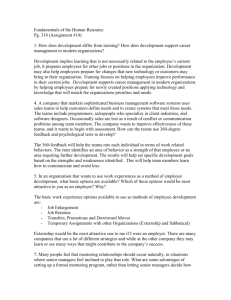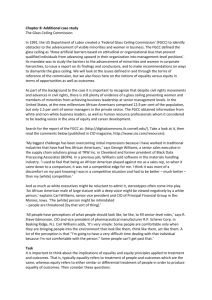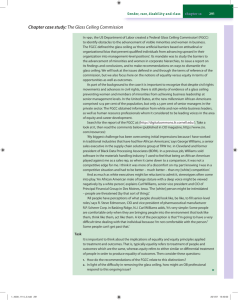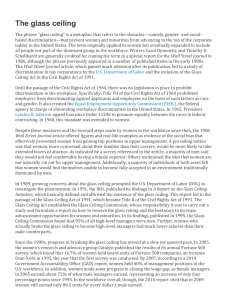Gender Issues in Leadership
advertisement
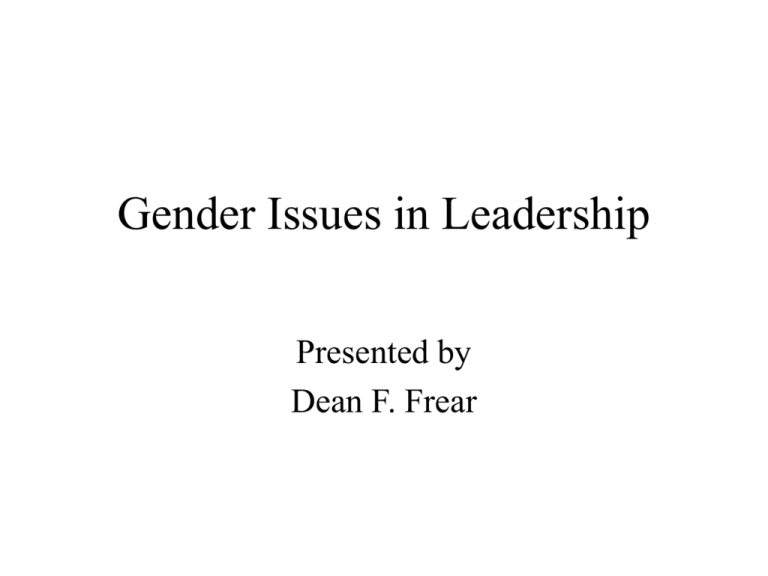
Gender Issues in Leadership Presented by Dean F. Frear Introduction Topics • • • • Gender-based discrimination Socialization Gender Neutrality Women in the workforce Emergent topics • • • • • Gender bias Lack of opportunity Equal pay Gendered occupations Under representation in upper management Barriers / Topics • • • • Glass ceiling Slow promotions Male-centered leadership model Early socialization process of boys and girls Sex Discrimination - Discriminatory Practices • Right to vote for women -Article 19 of the U. S. Constitution, August 26th, 1920 • Equal Rights Amendment - Congress passed it in 1972, but the amendment has never been ratified History of ERA • The 28th Article reads: “SECTION 1. Equality of rights under the law shall not be denied or abridged by the United States or by any State on account of sex.” History of ERA • In the 108th Congress (2003 - 2004), the Equal Rights Amendment has been introduced as (Sen. Edward Kennedy, MA, chief sponsor) and (Rep. Carolyn Maloney, NY, chief sponsor). ERA Ratification • The ERA remains unratified by many southern and western states. • Article 28 has no power to defend women’s rights. Civil Rights Act of 1964 • Protection for all • discrimination in employment on the basis of race, ethnicity, or sex has been explicitly prohibited by law Socialization • Traced to ---habits learned in early childhood socialization • Promotion of managers often depends on skill in negotiating authority and • Whether or not others support of undercut their efforts • Lower self-efficacy expectations than men Socialization • Men speak up, and women do not. • Women are less likely to blow their own horn, and therefore are less likely to be recognized • Girls are often taught to play quietly, and act in ways that will not attract attention • Men more often than women engage in behaviors that get them recognized with those in power Socialization • Women should be the primary caretakers of young children and relatives • Differences in labor-force attachment arise from a form of indirect discrimination Female language • • • • • • Polite and insecure Conversational style – cooperative Use fewer abstract words A smaller vocabulary A simpler structure Women use more adjectives, modal verbs, interjections, tag questions Male language • Assertive and direct • Conversational style - competitive Other characteristics of language • Differences according to - the status and age of the speaker relative to the status of the person spoken to Gender Neutrality • Women are diminished by a discourse of gender neutrality that renders women's distinctive circumstances --- invisible, irrelevant, or inappropriate • Expectation of being more like the masculine model for leadership required by many corporations, puts women at odds with gender neutrality theory Gender Neutrality • Hierarchical-bureaucratic model was not built on a gender integrated or a gender-in-common base of experience • Girls and women develop a sense of connection based on their original relationship with the (similar) mother • While boys' (men's) original issue is to separate from their (different) mothers and to become autonomous Gender Neutrality • Boys are taught to play war games or cowboys and indians • While girls play with dolls • Weaklings play with dolls • Therefore, girls are weaklings • The inference is --weaklings are not good leaders, this is generalized towards females at the workplace Leadership and Dependency • Only the strong survive –in general males are stronger than females • The meaning symbolically in the workplace is the strong male leadership model will survive, • While the weaker female leadership model will not survive Leadership and Dependency • Followers tend to follow strength • Strength viewed as a masculine trait • The implication -if a female leads the corporation, the weaker sex, the company will be weak Workforce • Nonprofit sector labor force - women make up the majority --- men are over represented in management positions • Wages men an average of $37,685 • Wages women an average of $31,125 • Conclusion, a glass ceiling exists resulting in lower salaries and lower managerial representation for women Glass Ceiling – Legitimate Power • An invisible barrier, the ‘glass ceiling,’ which prevents their rising further • The glass ceiling applies to women as a group who are kept from advancing higher because they are women Glass Ceiling – Legitimate Power • Keep women from rising above a certain level in organizations • Discrimination which increases women's probability of failure • Denying them access to developmental opportunities • Presenting only stereotypical challenges based on sex stereotypes Glass Ceiling – Pay • Exists for both promotions and pay raises and other organizational bonuses • Women are paid less • Receive less perks and time off for training and education • Disparities exist in the pay rates of male and female employees even when tenure, education, and skills are equated Glass Ceiling – Pay • Reaches all the way to the senior officer and CEO positions • 1997 57 female senior officers and 1772 male senior officers of fortune 500 companies, the average cash compensation for men - $765 000 Women - $518 596 Females - median of 68 cents for every dollar earned by their male counterparts Glass Ceiling – Legitimate Power • Women who are viewed as incompetent and doubt their own leadership abilities may be passed over • A recent study reported that 40% of the women had been denied a raise or promotion because of being a women Glass Ceiling – Legitimate Power • Attractive female managerial candidates received lower ratings of their performance, lower starting salaries, and fewer promotions than did unattractive females or attractive males Glass Ceiling – Legitimate Power • The most successful attractive males were rated as more capable than unattractive males • With women, the least attractive females were often seen as the most capable Workplace • The sex ratios, the ratio of men to women or women to men, exerts a great deal of influence on group behavior in organizations • Women are still often viewed as less effective leaders • Beliefs that women lack leadership abilities may lead to resistance to women in managerial positions Workplace • women are still often viewed as less effective leaders • Beliefs that women lack leadership abilities may lead to resistance to women in managerial positions

